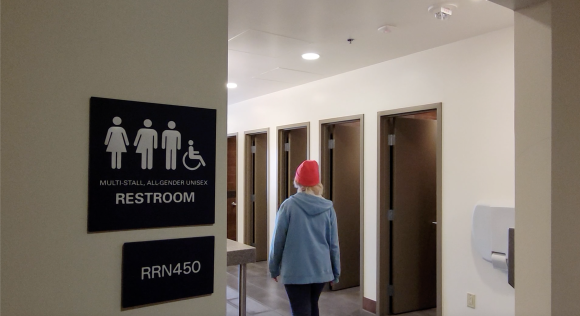
Roy MacDonald, a gender non-conforming CU undergraduate, walking into a multi-stall all-gender restroom on the fourth floor of the Center for Community building on Nov. 12, 2022. (Courtesy of Niles Honeywick)
Editor’s note: A version of this story was originally written for the College of Media, Communication and Information’s News Corps program.
Editor’s note, Jan. 26: This story has been updated to clarify the number of all-gender restrooms available on the campus map, the role of Facilities Management in constructing new campus buildings and updating the campus map, as well as the role of the university in allocating funding and abiding by plumbing codes.
Every day, Faye Kollig, a non-binary CU Boulder student, faces a frustrating bathroom dilemma. They have two options: to misgender themselves for the convenience of using a gendered bathroom near their office or spend more time and effort to find a gender-neutral bathroom in another building. Most days, tired and busy, they resign themselves to the first option.
“Queer people have to sacrifice their comfort and their sense of safety and belonging because this isn’t a battle you can fight every day,” Kollig said. “It can be very emotionally draining.”
Kollig, a Ph.D. student in the information sciences department, spends most of their school days in the Environmental Design Building, located across from the CU Art Museum. The building currently has no gender-neutral bathrooms.
In 2019, Morgan Scheuerman, a Ph.D. student in the same department who identifies as transmasculine non-binary, complained to the CU Boulder administration about this issue. Three years later, he says nothing has changed.
They aren’t the only ones who have raised this issue.
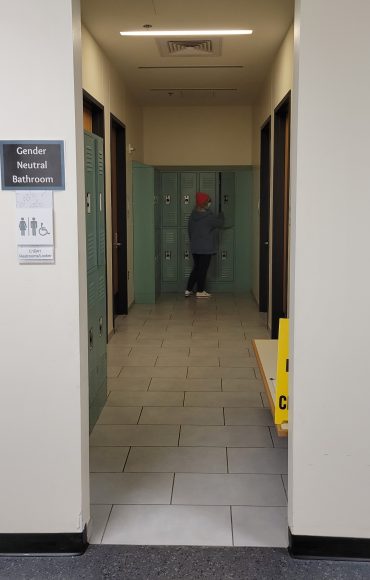
Roy MacDonald opening a locker located between four gender-neutral restrooms in the Jennie Smoly Caruthers Biotechnology Building on Nov. 12, 2022. (Courtesy of Niles Honeywick)
Accessibility concerns
An estimated 4.7% of CU’s total student population identifies outside the gender binary, according to CU Boulder’s 2021 Campus Culture Survey. The accessibility of gender-neutral bathrooms on CU Boulder’s campus affects the transgender, non-binary and gender non-conforming population at the university.
More than 90% of CU Boulder students, staff and faculty do not believe CU Boulder has enough gender-neutral bathrooms, according to a non-scientific survey of about 260 members of the campus community conducted through Qualtrics by CU News Corps reporter Niles Honeywick and distributed with help from the CU Pride Office and oSTEM. Seventy-six percent indicate at least one building they regularly use doesn’t have a gender-neutral bathroom, and 60.4% rated finding gender-neutral bathrooms on campus as a “difficult” or “very difficult” process.
For many of these people, gender-neutral bathrooms are a necessity for their mental and physical health and their personal safety. Gendered facilities have the potential to be unsafe places for transgender and non-binary people, where microaggressions, verbal harassment and even physical attacks may occur.
According to a 2015 survey by the National Center for Transgender Equality, 12% of transgender people faced verbal harassment in public bathrooms within the last year. Twenty-four percent of respondents said someone had “questioned or challenged their presence” in a public bathroom, and 9% reported they had been denied access to a bathroom.
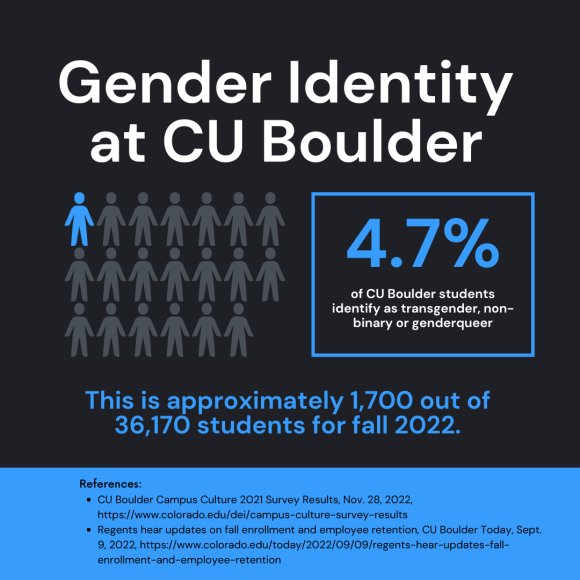
(Graphic by Izzy Fincher)
“When [a negative situation] happens once or twice, that’s enough to feel anxious every time someone walks out of a stall,” said engineering project consultant Natasha Ouellette, who is working to install gender-neutral bathrooms in CU Boulder’s Integrated Teaching and Learning Program facilities. “If you have enough of these experiences, you’re going to go to that fight or flight mode every time. Even if people aren’t causing that problem right now, you might not feel safe in that space in general.”
University officials are “not aware of any specific data that points to restrooms on the CU Boulder campus as spaces where harassment or violence are more prone to occur,” said spokesperson Andrew Sorensen in a statement to the CU Independent.
Gender-neutral facilities that offer safer inclusive spaces for transgender and non-binary students do not pose a safety risk for cisgender people, despite safety concerns from opponents of gender-inclusive policies, according to a recent study by the Williams Institute at the UCLA School of Law. The findings counter the “bathroom predator myth,” which portrays transgender women as dangerous sexual predators who endanger the safety of women and children in public bathrooms.
“CU Boulder recognizes the marginalization this community faces through increased societal and cultural anti-trans behavior and aims to create more inclusive environments on campus,” Sorensen said. “The university has preventative measures and support mechanisms in place to assist this community and other communities at higher risk.”
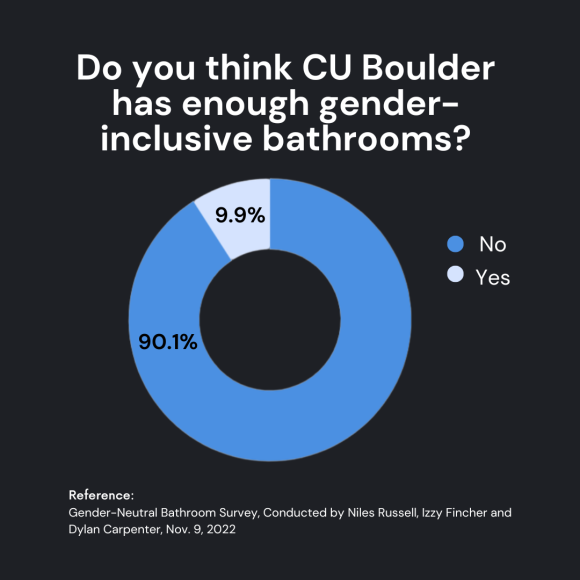
(Graphic by Izzy Fincher)
A shortage of gender-neutral facilities at CU
Over the past few years, CU Boulder has worked to expand access by offering 256 gender-neutral bathrooms on campus. Most of these gender-neutral bathrooms are not new facilities. Instead of adding new gender-neutral bathrooms, university officials changed the signage on many existing single-stall bathrooms from male or female to all-gender. Some signs are still temporary paper ones and have not been officially updated.
In newly constructed buildings or expansions, such as the Center for Academic Success and Engagement and Imig Music Building’s new addition, the university has included several gender-neutral bathrooms throughout the building.
Many older buildings still lack gender-neutral bathrooms. Most only have one for the entire building, which may not be sufficient for the occupant capacity, especially when cisgender people use these facilities as well. The existing facilities can be difficult to find because the interactive campus map, which the Strategic Relations and Communications Department has not yet fully updated, only lists about half of them. Out of 228 total buildings on campus, only 50 have gender-inclusive restrooms listed on the campus map.
According to the university, the number of all-gender restrooms available on the campus map is limited because restrooms in certain residential areas are not listed for privacy reasons.
Campus Pride ranked CU Boulder among the top 40 LGBTQ-Friendly Universities in the U.S. in 2020, 2021 and 2022. CU Boulder has more LGBTQ-inclusive policies than most universities in the country and is one of only 367 colleges and universities that list campus gender-inclusive restrooms on their website.
CU Boulder still falls short of other universities that strive to offer gender-inclusive facilities.
Some colleges, like Yale, offer interactive maps with detailed location information, which are integrated with Google maps for increased accessibility. The University of California Los Angeles’ Policy 890 has several provisions for gender-inclusive facilities, including clear signage and distance requirements. If a building has no gender-neutral bathroom, the nearest one must be a two-minute walk away at most. Any new construction plans must include a multi-stall gender-inclusive restroom.
At Harvard, the Gender Inclusive Restroom Mapping project created a web-based application to navigate these facilities across Harvard’s campuses.
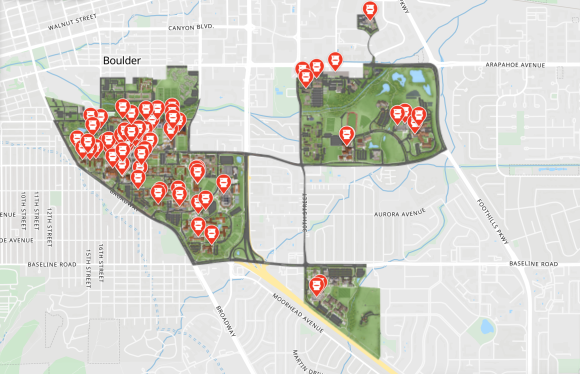
A screenshot of CU Boulder’s interactive campus map on Nov. 8, 2022 filtered to show gender-neutral bathroom locations with red pinpoints of toilets.
Regulations and funding issues
At CU Boulder, officials say one of the main barriers to improving and expanding current facilities is the state and international plumbing codes. The university follows the 2018 Colorado Plumbing Code, adopted from the 2018 International Plumbing Code (IPC), which requires a specific fixture count of toilets and urinals based on the total occupancy of a building with separate facilities for men and women.
The language indicates that separate facilities for men and women are mandated. An educational building must have one fixture for every 50 men and one fixture for every 50 women. A single-user toilet facility, intended for one person to use with complete walls and a lockable door, is permitted to be used by any gender and counts towards the total plumbing fixtures. If a single-stall bathroom is gender-neutral, however, it will not count toward the required gendered plumbing fixtures, though it may be added as additional facilities.
“CU Boulder is following all current adopted plumbing codes and will continue to do so as new code editions and their amendments are adopted,” wrote Charlotte Dennis, a spokesman for CU Boulder Strategic Media Relations, in an email to the CU Independent on Oct. 18. “The campus is planning for the flexibility that future editions of the plumbing code will allow.”
Another barrier includes a lack of campus-wide funding. Facilities Management, the department that maintains most on-campus buildings and coordinates some new construction projects, doesn’t have a budget allocated for gender-neutral bathroom renovations. Any construction fees must come directly from the individual department’s budget, which most cannot afford given their own budget constraints. According to the university, individual departments fund the construction of new buildings, and Facilities Management simply maintains them.
Bathroom renovations and construction can be very expensive. For example, it cost $176,400 to convert existing men’s and women’s bathrooms and a custodial storage closet into a six-stall all-gender facility at CU’s University Memorial Center in 2016. This project was funded by student fee money from the University of Colorado Student Government.
“[The lack of funding] is the hold-up on a lot of the remodels,” said Morgan Seamont, the director of CU Boulder’s Pride Office. “We just can’t afford it. Remodels can be very expensive. We’re all working under tight budgets, especially post-COVID, so we need some support either from the system level or from a high level within the university.”

Morgan Seamont, the director of CU’s Pride Office, standing in front of a bookcase in the Pride Office inside the Center for Community on Nov. 8, 2022. (Izzy Fincher, CU News Corps)
How did these efforts start?
The initiative to increase gender-neutral facilities on campus began over a decade ago as a grassroots effort within the CU LGBTQ+ community in partnership with the now-closed Gender and Sexuality Center in 2007. At the time, CU Boulder had no gender-neutral restrooms.
In 2010, CU Boulder built its first gender-neutral facilities in the new Center for Community building: a multi-stall all-gender bathroom on the fourth floor. In 2012, CUSG passed the Gender Inclusive Restroom Bill to assert its support for the construction of more gender-inclusive facilities on campus in student-fee-funded buildings. This initiative paid for gender-neutral bathroom and locker room renovations in the Recreation Center in 2014 and the 2016 bathroom renovation in the UMC.
The most significant gains came in the past few years after the pandemic.
In 2021, the IDEA Council, a representative body of students, staff and faculty that prioritizes inclusion, diversity and excellence initiatives on campus, recommended expanding the number of gender-neutral bathrooms on campus. The IDEA Council proposal recommended turning all single-stall bathrooms on campus into all-gender facilities by changing the signage.
“I felt like at some point [gender-neutral bathrooms] needed to take priority for the university,” said Regina Tirella, the senior director of support & safety measures at the Office of Institutional Equity and Compliance, who co-drafted the IDEA Council recommendation.
Since then, Facilities Management has made progress toward implementing this recommendation, bringing the number of all-gender single-stall bathrooms to 256.
Many of the sign updates are still temporary paper signs, which will be upgraded to permanent ones in the future. The Strategic Relations and Communications Department is also still in the process of updating the campus map with the locations of the new facilities.
Despite the university’s progress so far, some community members feel frustrated by the slow pace of renovations and the lack of transparency about timelines, funding and organizational structure in Facilities Management.
“It feels like there is no one person who is responsible and can be lobbied to make a change,” said Aisha Nammari, a CU Boulder alum and current university employee who works at the Laboratory for Atmospheric Space and Physics on East Campus. “It feels like everyone points their person at another group. It’s this circle that goes nowhere.”
In 2018, Nammari said she reached out to the CU Boulder administration about the lack of gender-neutral bathrooms at LASP, a research organization affiliated with CU Boulder that has over 100 employees. Four years later, no all-gender restrooms have been added to the facility.
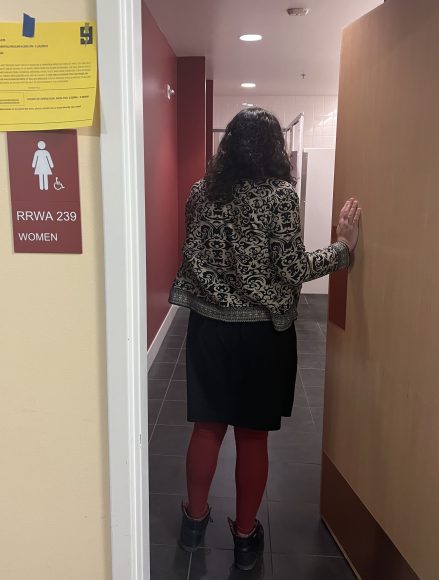
Aisha Nammari, a CU alum and current CU employee, walking into a women’s restroom in the Laboratory for Atmospheric and Space Physics on the third floor on Nov. 10, 2022. (Courtesy of Izzy Fincher)
Mental and physical health impacts
As the renovation timeline continues to stretch out, LGBTQ+ students on campus continue to struggle on a daily basis. The lack of gender-neutral facilities can have significant effects on their mental health, according to research published by the United Kingdom’s National Library of Medicine.
This is an example of the minority stress model, a framework that examines health disparities affecting racial and sexual minority communities and how external and internal stressors contribute to this. This theory can be used to understand the emotional stress experienced by transgender and gender non-conforming people when accessing and using gendered public bathrooms.
“Psychologically, a sense of belonging is incredibly important for individuals,” said Irene Blair, a CU Boulder psychology professor whose research focuses on stereotyping, prejudice and discrimination in health care.
According to a brief by the American Medical Association, the lack of access to facilities that match a person’s gender identity “endangers their health, safety and well-being, leads to negative health outcomes and heightens stigma and discrimination.”
Nearly 60% of transgender people in America have avoided public restrooms due to safety concerns and the fear of confrontation, according to the National Center for Transgender Equality (NCTE) survey.
“[The lack of gender-neutral bathrooms] has been really awkward for me,” Scheuerman said. “I switch up how I present all the time and then I have to choose which bathroom I use. I’ve had men try to tell me that I don’t belong in [a certain] bathroom.”
For those who avoid using the bathroom, the medical consequences can include urinary tract infections and constipation, as well as more serious conditions like hematuria, kidney disease and diverticulitis. These conditions are more common for people in their 40s, but they can develop earlier in life due to the trauma of not using the restroom as often as needed.
In the NCTE study, 32% of transgender people said they limited their intake of food and drinks to avoid using public bathrooms, and 8% reported a kidney or urinary tract infection, or other kidney-related medical condition, as a result of bathroom avoidance.
Given the significant mental and physical impact of bathroom policies on transgender and non-binary people, activists and policymakers have been lobbying for gender-inclusive policy changes. Their work has resulted in updated policies on a state and national level, which make gender-inclusive bathrooms easier to advocate for and implement.
“There have been changes to plumbing codes that make them no longer the highest barrier,” said Lisa Flores, the co-chair for the IDEA council and the associate dean of diversity, equity and inclusion at the College of Media, Communication and Information.
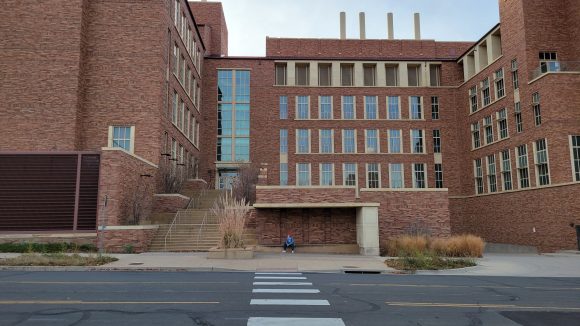
Roy MacDonald sits in front of the Jennie Smoly Caruthers Biotechnology Building on Nov. 12, 2022. (Courtesy of Niles Honeywick)
Plumbing code woes
The 2021 International Plumbing Code(IPC) includes updated policies for all-gender restrooms. A multi-stall restroom means multiple toilets or urinals are available, and these fixtures are separated by walls and a swinging door that can be fixed shut. Inside sex-segregated restrooms, these walls often have large gaps. An all-gender multi-stall restroom typically requires floor-to-wall ceilings and doors.
Multi-stall restrooms allow more people to access them and are more efficient than single-stall restrooms. The new policy no longer requires floor-to-ceiling walls and doors in multi-stall gender-neutral bathrooms. This means that more multi-stall restrooms, even those with large gaps between the floor and ceiling, can be converted into gender-neutral facilities, thus reducing renovation costs and increasing accessibility.
Colorado will not adopt the latest version of the IPC until 2024, according to Edward Stafford, the interim chief building official for the City of Boulder. By then, the code will likely include further updates for gender-inclusive facilities.
In Boulder, city staff have created more gender-inclusive building and plumbing codes than the 2018 IPC, according to Stafford.
Boulder’s regulations mandate that single-stall restrooms should be made available to people of all genders. All-gender restrooms will be included in fixture counts and separate gendered restrooms are not required to comply with the code. In addition, directions to the location of gender-neutral restrooms must be available at the main entrance of a building for convenience.
However, the university is not under Boulder’s jurisdiction for building and plumbing codes. Therefore, these amendments don’t apply to the CU Boulder campus. The university adheres to state codes like other higher education institutions in Colorado.
In the next few years, as the state adopts newer international plumbing codes, Ouellette said the only barrier left for the expansion of gender-neutral bathrooms at CU will be the lack of funding allocated by the university for these renovations.
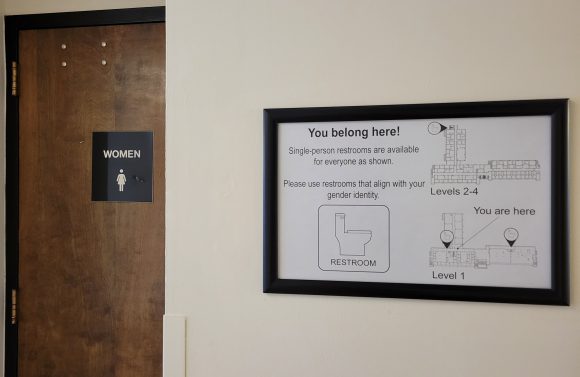
A directory sign on the first floor of Muenzinger labels locations of gender-inclusive restrooms in the building on Oct. 20, 2022. (Niles Russell, CU News Corps)
Looking forward
Despite the high costs associated with gender-neutral bathroom renovations and construction, many in the CU community feel that the benefits outweigh the costs. A campus with accessible bathrooms for people of all gender identities fosters an inclusive, equitable environment, according to Kollig.
“I wish I could put a price on my pain and my emotional struggle with [the lack of gender-neutral bathrooms at CU],” Kollig said. “The actual renovation cost is all that people in the bureaucracy seem to think about. But when you’re doing the cost-benefit analysis, it’s really clear that the cost of the physical and mental pain for students, staff and faculty is pretty clearly higher than the cost of renovations.”
Kollig and their peers believe that the university could still be doing more to address their concerns right now and move the renovation process forward faster in the future. They want more transparency from the university about the renovation process, timelines and budgets related to gender-neutral restrooms.
The first step Kollig would like to see would be updating the interactive campus map with all 256 gender-neutral bathrooms as soon as possible. They want to see an estimated timeline and completion date from the Strategic Relations and Communications Department, instead of a vague timeline.
In addition, Seamont and Scheuerman think that the university should prioritize adding more signage. According to Seamont, campus officials could improve the signage around all-gender bathrooms by adding signs to every gendered bathroom door that provide directions to the nearest gender-neutral bathroom.
Scheuerman added that gender-affirming signage could be implemented across campus to encourage people to use the bathroom that best aligns with their gender identity. This could help to cultivate a more welcoming environment and reduce microaggressions and verbal harassment on campus against those that are not cisgender, especially in gendered facilities.
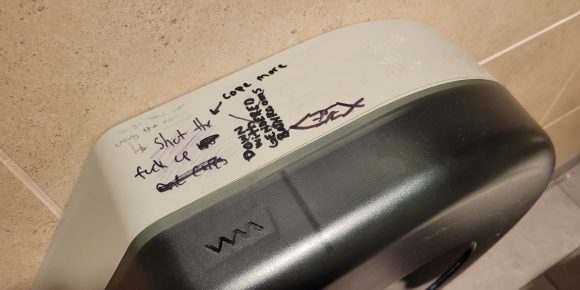
Grafitti in the left all-gender restroom on the second floor of the Norlin Library on Oct. 4, 2022. (Courtesy of Niles Honeywick)
Demanding action and accountability
However, to implement these changes on a campus-wide scale, the university would need to allocate more resources and staff toward the issue and improve internal communication.
“Our frustration comes when we try to talk to Facilities Management or whoever might have [funding] because that’s where the conversation stalls or stops,” Seamont said. “[They say] they don’t have any resources, which doesn’t do anything to solve the problem, or it’s not their responsibility.”
Often, the responsibility to advocate for and coordinate these initiatives falls to the Pride Office, which has a staff of two people, Seamont and Pride Office Assistant Director Alex Dutro-Maeda.
“I hope students know that we do as much as we possibly can, but we are a two-person office,” Seamont said. “We would love to have more allies in other departments because that would help us get [our work] done more quickly or at least come up with some temporary solutions. We need to be able to work together to solve these problems.”
Ideally, in the near future, LGBTQ+ students, staff and faculty want to see gender-neutral bathrooms in every building on campus and, if possible, on every floor. However, many recognize this ambitious goal may not be possible for many years considering the funding and human and material resources involved.
Increasing the number of gender-neutral bathrooms on campus would simply be meeting “the bare minimum,” according to Kollig. To truly address systemic inequities affecting LGBTQ+ students on campus, they say the university must consider creating inclusive restroom layout designs to meet the needs of people across the spectrum of different identities and abilities.
“There are so many factors that go into accessibility besides the existence of a facility,” Kollig said. “The facility’s existence doesn’t matter unless the entire process of using the facility is streamlined; until it’s just as easy for queer people to use as it is for cisgender people.”
Contact CU Independent Managing Editor Izzy Fincher at isabella.fincher@colorado.edu.
Contact CU Independent Guest Writer Niles Honeywick at niles.russell@colorado.edu.
Contact CU Independent Guest Writer Dylan Carpenter at dylan.carpenter@colorado.edu.
